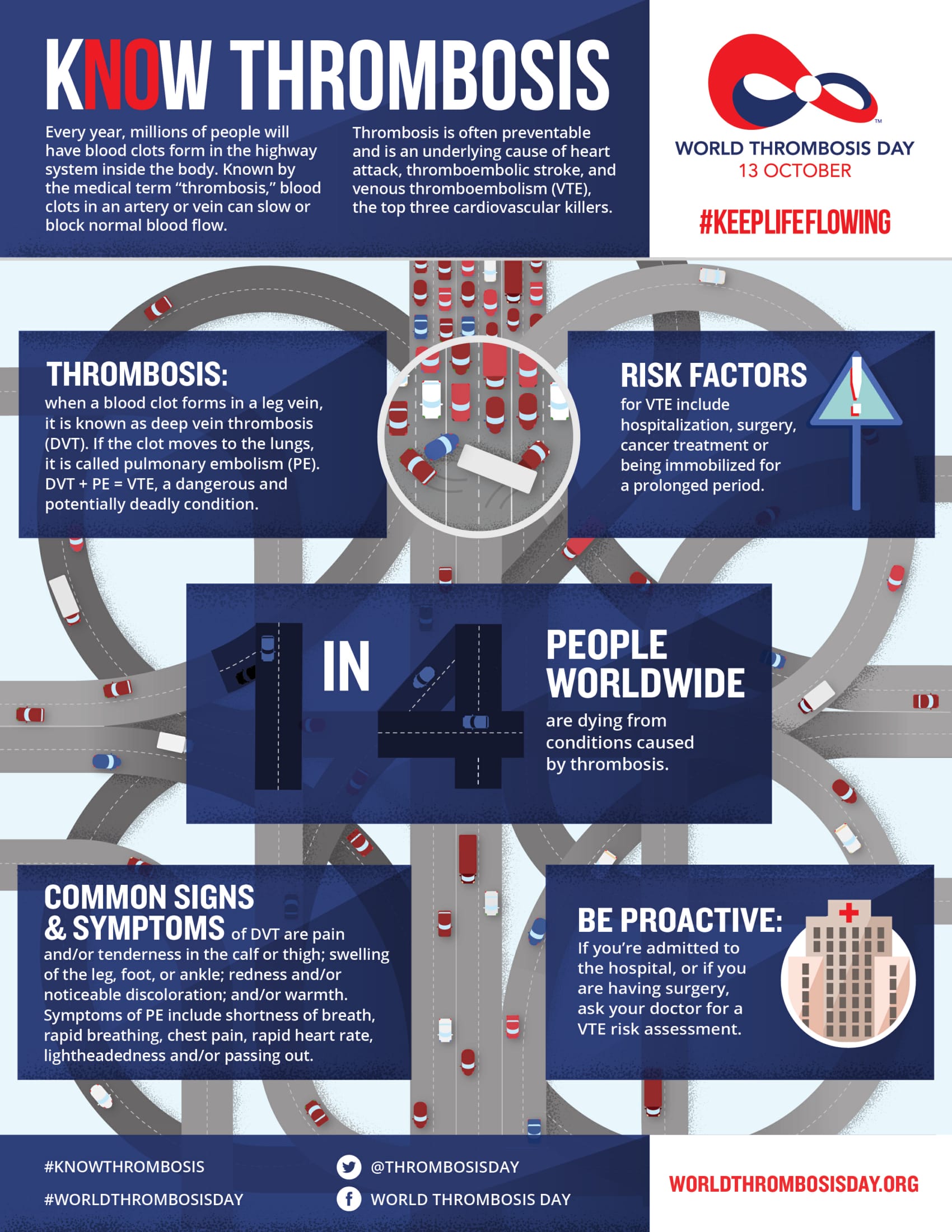Deep vein thrombosis (DVT) sometimes occurs for no apparent reason.
However, the risk of developing DVT is increased in certain circumstances.
Inactivity
When you’re inactive your blood tends to collect in the lower parts of your body, often in your lower legs. This is usually nothing to worry about because when you start to move, your blood flow increases and moves evenly around your body.
However, if you’re unable to move for a long period of time – such as after an operation, because of an illness or injury, or during a long journey – your blood flow can slow down considerably. A slow blood flow increases the chances of a blood clot forming.
In hospital
If you have to go into hospital for an operation or procedure, your risk of getting a blood clot increases. This is because DVT is more likely to occur when you’re unwell or inactive, or less active than usual.
As a patient, your risk of developing DVT depends on the type of treatment you’re having. You may be at increased risk of DVT if any of the following apply:
you’re having an operation that takes longer than 90 minutes, or 60 minutes if the operation is on your leg, hip or abdomen
you’re having an operation for an inflammatory or abdominal condition, such as appendicitis
you’re confined to a bed, unable to walk, or spending a large part of the day in a bed or chair for at least three days
You may also be at increased risk of DVT if you’re much less active than usual because of an operation or serious injury and have other DVT risk factors, such as a family history of the condition.
When you’re admitted to hospital you’ll be assessed for your risk of developing a blood clot and, if necessary, given preventative treatment.
Blood vessel damage
If the wall of a blood vessel is damaged, it may become narrowed or blocked, which can cause a blood clot to form.
Blood vessels can be damaged by injuries such as broken bones or severe muscle damage. Sometimes, blood vessel damage that occurs during surgery can cause a blood clot, particularly in operations on the lower half of your body.
Conditions such as vasculitis (inflammation of the blood vessels), varicose veins and some forms of medication, such as chemotherapy, can also damage blood vessels.
Medical and genetic conditions
Your risk of getting DVT is increased if you have a condition that causes your blood to clot more easily than normal. These conditions include:
cancer – cancer treatments such as chemotherapy and radiotherapy can increase this risk further
heart disease and lung disease
infectious conditions, such as hepatitis
inflammatory conditions, such as rheumatoid arthritis
thrombophilia – a genetic condition where your blood has an increased tendency to clot
antiphospholipid syndrome – an immune system disorder that causes an increased risk of blood clots
Pregnancy
During pregnancy, blood clots more easily. It’s the body’s way of preventing too much blood being lost during childbirth.
Venous thromboembolism (VTE) – DVT and pulmonary embolism – affects about one in 100,000 women of childbearing age.
DVTs are also rare in pregnancy, although pregnant women are up to 10 times more likely to develop thrombosis than non-pregnant women of the same age. A clot can form at any stage of pregnancy and up to six weeks after the birth.
Having thrombophilia (a condition where the blood has an increased tendency to clot), or having a parent, or brother or sister, who’s had a thrombosis, increase your risk of developing a DVT during pregnancy.
Other risk factors during pregnancy include:
being over 35 years old
being obese (with a BMI of 30 or more)
expecting two or more babies
having recently had a caesarean section
being immobile for long periods of time
smoking (find out how to stop smoking)
having severe varicose veins
Low molecular weight heparin (LMWH) is usually used to treat pregnant women with DVT. LMWH is an anticoagulant, which means it prevents the blood clot getting bigger. It’s given by injection and doesn’t affect your developing baby.
Read more about DVT in pregnancy.
Contraceptive pill and HRT
The combined contraceptive pill and hormone replacement therapy (HRT) both contain the female hormone oestrogen. Oestrogen causes the blood to clot a bit more easily than normal, so your risk of getting DVT is slightly increased. There’s no increased risk from the progestogen-only contraceptive pill.
Other causes
Your risk of getting DVT is also increased if you or a close relative have previously had DVT and:
you’re overweight or obese
you smoke
you’re dehydrated
you’re over 60 – particularly if you have a condition that restricts your mobility
Glossary
- HRT
- Hormone replacement therapy or HRT involves giving hormones to women when the menopause starts, to replace those that the body no longer produces.
- Vein
- Veins are blood vessels that carry blood from the rest of the body back to the heart.
- Blood
- Blood supplies oxygen to the body and removes carbon dioxide. It is pumped around the body by the heart.
- Anaesthetic
- Anaesthetic is a drug used to either numb a part of the body (local), or to put a patient to sleep (general) during surgery.
- Chemotherapy
- Chemotherapy is a treatment of an illness or disease with a chemical substance, e.g. in the treatment of cancer.
- Inflammation
- Inflammation is the body’s response to infection, irritation or injury, which causes redness, swelling, pain and sometimes a feeling of heat in the affected area.
- Heart
- The heart is a muscular organ that pumps blood around the body.
- Obesity
- Obesity is when a person has an abnormally high amount of body fat.
- Genetic
- Genetic is a term that refers to genes- the characteristics inherited from a family member.



